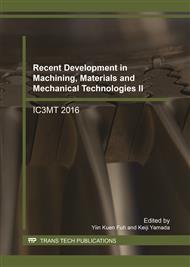[1]
G.C. Everstine, and A.C. Pipkin, Stress channeling in transversely isotropic elastic composites, Zeitschrift für Angewandte Mathematik und Physik. 22 (1971) 825-834.
DOI: 10.1007/bf01591811
Google Scholar
[2]
R.B. Pipes, Boundary layer effects in composite laminates, Fibre Science and Technology. 13 (1980) 49-71.
DOI: 10.1016/0015-0568(80)90028-7
Google Scholar
[3]
R.M. Jones, Mechanics of Composite Materials, second ed., CRC Press, (1998).
Google Scholar
[4]
C.O. Horgan, Saint-Venant end effects in composites, Journal of Composite Materials. 16 (1982) 411-422.
DOI: 10.1177/002199838201600506
Google Scholar
[5]
L. Carlsson, P. Sindelar, S. Nilsson, Decay of end effects in graphite/epoxy bolted joints, Composites Science and Technology. 26 (1986) 307-321.
DOI: 10.1016/0266-3538(86)90004-7
Google Scholar
[6]
D.L. Bartel, D.T. Davy, T.M. Keaveny, Orthopaedic Biomechanics: Mechanics and Design in Musculoskeletal Systems, first ed., Prentice Hall, (2006).
Google Scholar
[7]
S. Dimitrievska et al , Novel carbon fiber composite for hip replacement with improved in vitro and in vivo osseointegration, Journal of Biomedical Materials Research Part A. 91A (2009) 37-51.
DOI: 10.1002/jbm.a.32175
Google Scholar
[8]
S.A. Hacking et al, Tissue response to the components of a hydroxyapatite-coated composite femoral implant, Journal of Biomedical Materials Research Part A. 94A (2010) 953-960.
Google Scholar
[9]
C. -L. Tsai, I.M. Daniel, Determination of shear modulus of single fibers, Experimental Mechanics. 39 (1999) 284-286.
DOI: 10.1007/bf02329806
Google Scholar
[10]
Q. -S. Yanga, Q. -H. Qin, Modelling the effective elasto-plastic properties of unidirectional composites reinforced by fibre bundles under transverse tension and shear loading, Materials Science and Engineering: A. 334 (2003) 140-145.
DOI: 10.1016/s0921-5093(02)00399-4
Google Scholar
[11]
Y. Benveniste, A new approach to the application of Mori-Tanaka's theory in composite materials, Mechanics of Materials. 6 (1987) 147-157.
DOI: 10.1016/0167-6636(87)90005-6
Google Scholar
[12]
T. Mori, K. Tanaka, Average Stress in matrix and average elastic energy of materials with misfitting inclusions, Acta Metallurgica. 21 (1973) 571-574.
DOI: 10.1016/0001-6160(73)90064-3
Google Scholar
[13]
G.P. Tandon, G.J. Weng, The effect of aspect ratio of inclusions on the elastic properties of unidirectionally aligned composites, Polymer Composites. 5 (1984) 327-333.
DOI: 10.1002/pc.750050413
Google Scholar
[14]
J.D. Eshelby, The determination of the elastic field of an ellipsoidal inclusion, and related problems, Proceedings of the Royal Society of London Series A. 241 (1957) 376-396.
DOI: 10.1098/rspa.1957.0133
Google Scholar
[15]
T. Lan, T.J. Pinnavaia, Clay-reinforced epoxy nanocomposites, Chemistry of Materials. 6 (1994) 2216-2219.
DOI: 10.1021/cm00048a006
Google Scholar
[16]
W. Liu, S.V. Hoa, M. Pugh, Organoclay-modified high performance epoxy nanocomposites, Composites Science and Technology. 65 (2005) 307-316.
DOI: 10.1016/j.compscitech.2004.07.012
Google Scholar
[17]
S.C. Tjong, Structural and mechanical properties of polymer nanocomposites, Materials Science and Engineering: R: Reports. 53 (2006) 73-197.
DOI: 10.1016/j.mser.2006.06.001
Google Scholar


